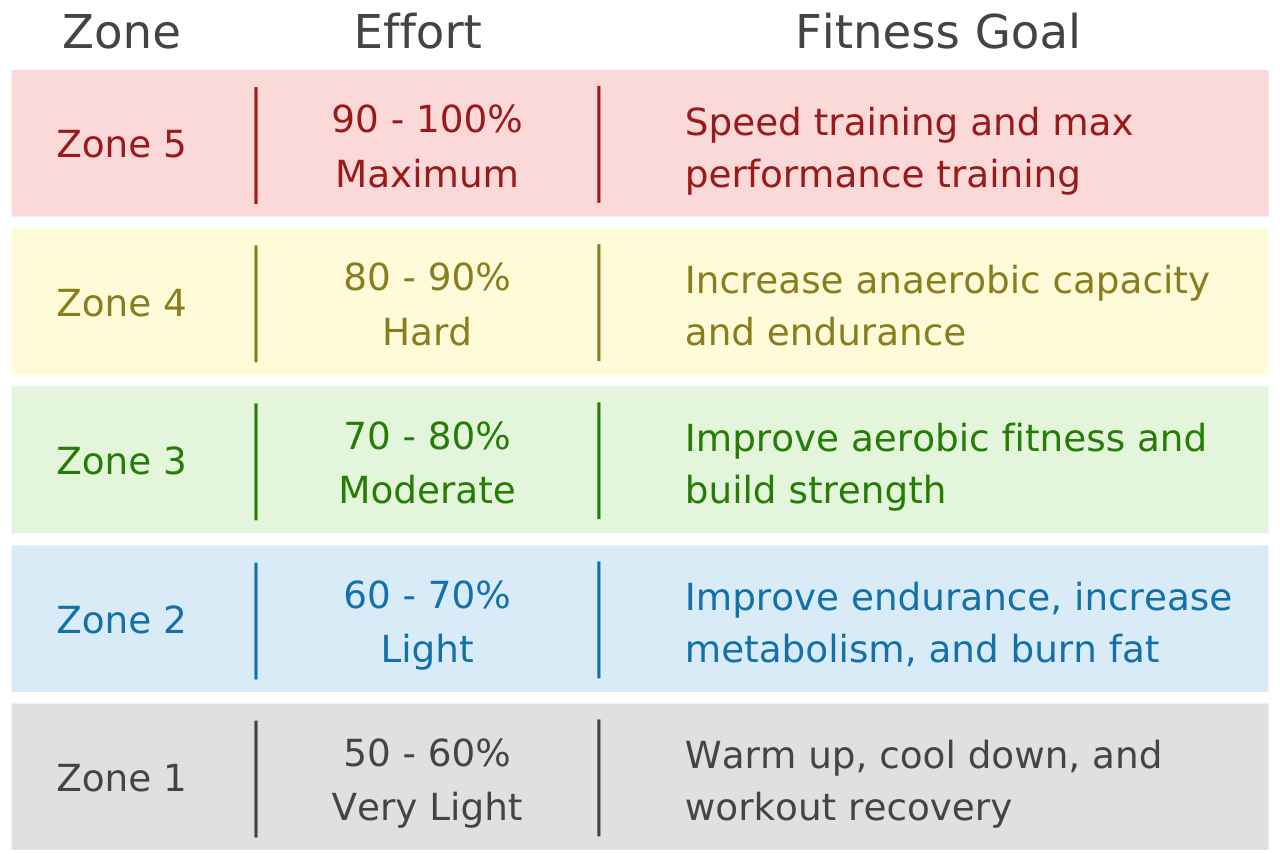Zone 2 Heart Rate Calculator
Use our zone 2 heart rate calculator to find your optimal zone 2 heart rate range.
Zone 2 Range:
Max Heart Rate
On this page:
- Calculator
- How to Calculate Your Zone 2 Heart Rate Range
- Heart Rate Zones
- Zone 2 Heart Rate Formula
- Benefits of Zone 2 Training
- Muscular Adaptations
- Types of Muscle Fibers
- Type I Fibers
- Type II Fibers
- Muscle Fibers – Can You Change Your Genetic Makeup?
- Aerobic vs. Anaerobic Training: Muscle Adaptations
- Increased Aerobic Capacity
- Utilization of the Oxidative Energy System
- Increased Strength and Muscle Mass
- Cardiovascular Adaptations
- Respiratory Adaptations
- Breathing Frequency and Tidal Volume – An Explanation
- Neural Adaptations
- Bone Adaptations
- References
How to Calculate Your Zone 2 Heart Rate Range
Measuring your heart rate can be an effective way to optimize training and tailor a program toward specific health and wellness goals.
Zone 2 exercise is performed at 60-69% of your max heart rate. Endurance athletes such as marathon runners might recognize this particular training zone when performing long-distance runs, since it appears to be the sweet spot for making the cardiovascular system more efficient and improving VO2 max.
Heart Rate Zones

When used for specific training purposes, the goal is that the intensity of your exercise may be lower than your competition intensity; however, the distance or duration of your workout should be longer (often between 30 minutes and 2 hours, depending upon the exercise and the training program).
You can use the max heart rate formula to find your zone 2 range.
Zone 2 Heart Rate Formula
Since your zone 2 heart rate is based on a percentage of your max heart rate, the first step is to calculate your max heart rate.
max heart rate = 220 – age in years
Then, you can multiply your max heart rate by 60-69% to find your zone 2 range.
zone 2 range = (max HR × 0.6) to (max HR × 0.69)
Benefits of Zone 2 Training
The benefits of zone 2 training include enhanced cardiovascular and thermoregulatory functioning (the ability to regulate your body temperature), increased cellular energy production, improvements to the oxidative capacity of skeletal muscles, and an increase in the utilization of fat as fuel, to name a few.
These physiological changes all contribute to the body’s ability to clear lactate, which can then improve your ability to recover following a workout.
Muscular Adaptations
If you’ve ever wondered why some individuals have muscles that appear large or bulky while others can look toned and defined, the reason is largely due to the type of muscle fibers being trained.
Types of Muscle Fibers
Type I Fibers
Type I fibers have a smaller diameter, which can give individuals with a higher percentage of these fibers a thinner or more toned look.
Type I (slow twitch) muscle fibers are efficient and fatigue-resistant, providing a high capacity for aerobic activity and limited potential for rapid force production.
Type II Fibers
Type II fibers have a larger diameter, which can give individuals with higher percentages of this type of muscle fiber a more hypertrophied or bulkier physique.Type II (fast twitch) muscle fibers are characterized as being inefficient and easily fatigued; however, they have a low capacity for aerobic activity but a higher capacity for anaerobic power and rapid force development.
If we break type ll fibers down even further, we find that there are actually two subtypes: type IIa and type IIx. Type IIa respond more quickly than slow twitch muscle fibers, but are not as resistant to fatigue. On the flip side, type IIx fibers twitch the fastest – however, they become fatigued very quickly.[1]
Along with the different physiological capabilities of these muscle types, they also present with different physical characteristics.
Muscle Fibers – Can You Change Your Genetic Makeup?
The human body is composed of both types of fibers, and based on genetics, individuals may be predisposed to having a higher percentage of one type versus the other. Research has often debated whether or not muscle fibers can transition from one type to another; while there are subtle changes that can occur, it does appear as though the body does show some resistance to completely altering to different fiber types.[1]
There is little evidence to support that the muscle fibers will change types completely. However, based on the training one undergoes, one may target a specific muscle fiber type and facilitate adaptation.
Aerobic vs. Anaerobic Training: Muscle Adaptations
Through aerobic training, type I fibers are targeted, and a percentage of type II fibers (the type IIa fibers) may adapt and take on physical characteristics more similar to the smaller type I fibers compared to the larger type IIx fibers.
On the other hand, during anaerobic training or training involving rapid force development, type IIx fibers are trained, and the type IIa fibers may adapt and adopt characteristics more similar to that of the larger type IIx fibers.
So, although we are not necessarily changing the percentage of type I versus type II fibers we are genetically disposed to, specific training methods can induce changes (both physically and physiologically) that give the appearance of having more or less of a certain fiber type.
Zone 2 training is an aerobic training zone, thus relying largely on type I muscle fibers, and over time, facilitating type IIa fibers to adapt to meet the demands necessary to elicit training results.
Increased Aerobic Capacity
Specific muscular adaptations that occur with zone 2 training include an increased aerobic capacity of the trained muscles, meaning they are adapting to optimally utilize the available oxygen in order to produce energy. This leads to an increased ability to exercise at greater relative intensities before fatigue occurs.
Utilization of the Oxidative Energy System
A second benefit of zone 2 training includes the utilization and training of the oxidative energy system as opposed to the phosphagen or glycolytic systems. The oxidative energy system has a glycogen-sparing effect, meaning it utilizes fat as its main source of energy, resulting in greater fat burning or fat utilization within the muscles.
Increased Strength and Muscle Mass
Lastly, since zone 2 exercise utilizes mainly type I fibers, the hypertrophy or growth of these fibers can lead to an increase in strength and muscle mass without a significant increase in muscular size (cross-sectional area) as seen with the hypertrophy of type II muscle fibers.
Cardiovascular Adaptations
Training of the cardiovascular system is important for many reasons, including but not limited to improving factors such as heart health, respiratory function, oxygen delivery, and recovery.
These benefits are seen with zone 2 training specifically, as training in this zone can lead to adaptations such as increased maximal cardiac output, increased stroke volume, reduced resting heart rate, and increased muscle fiber capillary density.
Throughout zone 2 training, one’s heart must adapt to pumping at an increased rate for an extended period of time, leading to physical adaptations that make it more efficient in doing so. Cardiac output and stroke volume are two such factors that can be positively manipulated through zone 2 training.
Adaptations of these values are caused by the heart’s increased efficiency at pumping blood. As these values improve and the heart becomes more efficient, one may see a resulting decrease in resting heart rate, indicating that the heart does not have to beat as often in order to meet the energy and oxygen demands of the body.
Zone 2 training requires a constant increased supply of oxygenated blood reaching the muscles. As a result of this, the capillaries – which are responsible for the nutrient exchange within the muscles – adapt and increase in density. This increased capillary density improves the ability of the body to deliver oxygen to the muscles and remove the carbon dioxide, increasing the available nutrients and energy for those muscles.
Respiratory Adaptations
The lungs are an inherently efficient organ. In healthy lungs, it is less likely that the lung’s ability to take in oxygen or dispel carbon dioxide limits function.
Research from the International Journal of Exercise Science noted that increases in oxygen intake can be achieved with zone 2 training, even among conditioned athletes. The study showed an increase in oxygen intake in those participants who trained in zone 2 (compared to other participants who exercised in zone 1).[2]
So, what does this mean to the layperson? Training in zone 2 can aid in improving oxygen consumption during a workout, and therefore improve performance. These results can obviously advance when entering zones 3-5, if desired. Other respiratory factors, such as breathing frequency or tidal volume, can also be improved with zone 2 training.
Breathing Frequency and Tidal Volume – An Explanation
Let’s think of a real-life example of these respiratory considerations. If you’ve ever gone for a run or climbed multiple stairs, you have probably noticed an increase in the frequency or intensity of your breathing. Breathing frequency is the amount of breaths one takes over a given timeframe, and is a result of your lungs attempting to get oxygen for your circulatory system while expelling the carbon dioxide that is being produced.
Tidal volume can be thought of as how much air your lungs move during a complete cycle of breathing – both the inhalation and exhalation. Breathing frequency and tidal volume both correlate closely with the efficiency of your cardiovascular system, but also play a role in your overall fitness level.
As mentioned above, zone 2 training may affect the cardiovascular system’s adaptations more than the respiratory system. However, just because the adaptations may not be as drastic compared to higher zone training, does not mean they are not occurring.
Neural Adaptations
With zone 2 training, the neural firing (and resulting muscular contractions) occur repetitively and for a long duration of time, leading to positive adaptations in the efficiency of your neurological system.
The nervous system becomes more efficient with “rotating” neural activity rather than being in a constant state of activation in order to achieve low-level muscular force production. The resulting increased efficiency of neural firing can lead to a delayed fatigue of the contractile mechanisms, or, in more simple terms, increased endurance.
Bone Adaptations
Bone and connective tissues adapt just as other tissues in the human body do. These structures will adapt to the stresses imposed upon them, such as with physical activity.
Bones adapt to compressive forces, meaning with every muscular contraction or every step, the compressive forces that stress the bones cause them to adapt and strengthen. The magnitude and load of the forces placed on bone will affect how much or little they adapt.
This means that higher-impact activities, such as running or jumping, would result in more adaptation than lower-impact activities, such as biking or swimming.
However, as the body adapts, an increase in the magnitude or load of the stimuli is required to produce continued adaptations. With this in mind, as the bones adapt, they may require higher-intensity exercises for continued adaptation.
References
- Plotkin D.L., Roberts M.D., Haun C.T., Schoenfeld B.J., Muscle Fiber Type Transitions with Exercise Training: Shifting Perspectives, Sports (Basel), 2021 Sep 10, 9(9), 127. https://www.ncbi.nlm.nih.gov/pmc/articles/PMC8473039/
- Neufeld E.V., Wadowski J., Boland D.M., Dolezal B.A., Cooper C.B., Heart Rate Acquisition and Threshold-Based Training Increases Oxygen Uptake at Metabolic Threshold in Triathletes: A Pilot Study, International Journal of Exercise Science, 2019 Jan 1, 12(2), 144-154. https://www.ncbi.nlm.nih.gov/pmc/articles/PMC6355121/


